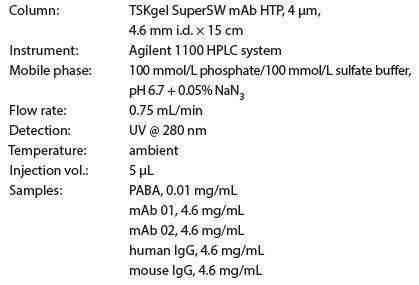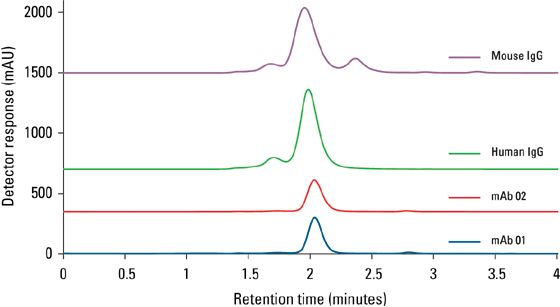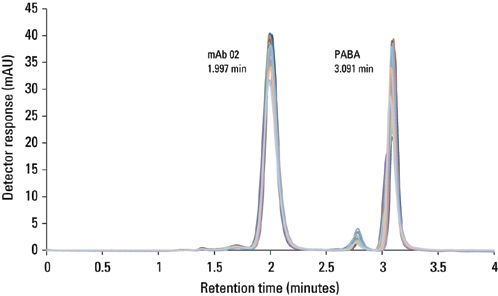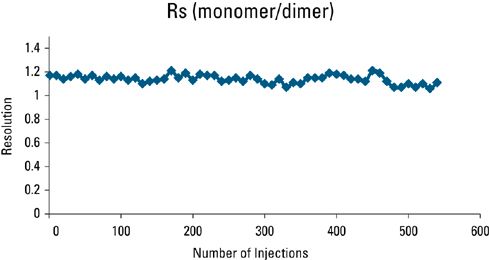High Throughput Sub-4 Min Separation of Antibodies Using Size Exclusion Chromatography
The Application Notebook
Gel filtration chromatography (GFC) is a powerful analytical tool in the separation of antibodies. Traditionally, GFC columns with a dimension of 7.8 mm i.d. × 30 cm are used for analytical purposes.
Gel filtration chromatography (GFC) is a powerful analytical tool in the separation of antibodies. Traditionally, GFC columns with a dimension of 7.8 mm i.d. × 30 cm are used for analytical purposes. The longer column dimension, however, leads to longer run times and sample dilution, as well as substantial solvent waste. Alternatively, a column of smaller dimension provides high throughput separation with shorter run times, high resolution, and minimal solvent waste when used on a conventional HPLC system. This application note demonstrates the use of a 4.6 mm i.d. × 15 cm TSKgel® SuperSW mAb HTP SEC column for the highly reproducible separation of antibodies in less than 3.5 min by using a moderate flow rate of 0.75 mL/min. The TSKgel SuperSW mAb HTP column provides excellent stability for high speed, sub-4 min separations of monoclonal antibodies.
Materials and Methods

Results and Discussion
Figure 1 shows the separation of four different monoclonal antibodies in less than 3 min using the TSKgel SuperSW mAb HTP column at a flow rate of 0.75 mL/min. High resolution separation of the monomer, dimer, and fragment peaks of the mouse IgG sample are clearly shown under these conditions. The separation of these IgG-based proteins within 3 min using the TSKgel SuperSW mAb HTP column corresponds to a 3.75-fold decrease in analysis time relative to conventional (7.8 mm i.d. × 30 cm) SEC columns.

Figure 1: Separation of monoclonal antibodies on TSKgel SuperSW mAb HTP column under high flow conditions.
Sustained pressure from operating at elevated flow rates can lead to voids within the column, generating poor peak shapes and drifting retention time. As shown in Figure 2, 540 consecutive injections of mAb 02 and PABA separated on the TSKgel SuperSW mAb HTP column at 0.75 mL/min show good reproducibility with no discernible drift in retention. Additionally, no significant loss in resolution between the mAb monomer and dimer was observed on the TSKgel SuperSW mAb HTP column operated at 0.75 mL/min, yielding a %RSD < 3 (Figure 3).

Figure 2: Retention time reproducibility of the TSKgel SuperSW mAb HTP column under high flow conditions.
Conclusions
Separations of IgG-based proteins using the TSKgel SuperSW mAb HTP column at 0.75 mL/min yielded highly reproducible results with high resolution and moderate back pressure within 3 min. This corresponds to a 3.75-fold decrease in analysis time relative to traditional SEC methodology. Additionally, due to the smaller dimension of the TSKgel SuperSW mAb HTP column, minimal solvent waste is observed even at increased flow rates, making this a cost effective and "green" method for protein separations when compared to that of traditional 7.8 mm i.d. × 30 cm SEC columns. The TSKgel SuperSW mAb HTP column operated at 0.75 mL/min for 540 injections of monoclonal antibody showed no drift in retention and good reproducibility. These results demonstrate that the TSKgel SuperSW mAb HTP, 4 μm, 4.6 mm i.d. × 15 cm column clearly has a competitive advantage in fast assay and high throughput analysis of antibodies using a conventional HPLC system.

Figure 3: Resolution stability of the TSKgel SuperSW mAb HTP column under high flow conditions.
Tosoh Bioscience and TSKgel are registered trademarks of Tosoh Corporation.

Tosoh Bioscience LLC
3604 Horizon Drive, Suite 100, King of Prussia, PA 19406
tel. (484) 805-1219, fax (610) 272-3028
Website: www.tosohbioscience.com

SEC-MALS of Antibody Therapeutics—A Robust Method for In-Depth Sample Characterization
June 1st 2022Monoclonal antibodies (mAbs) are effective therapeutics for cancers, auto-immune diseases, viral infections, and other diseases. Recent developments in antibody therapeutics aim to add more specific binding regions (bi- and multi-specificity) to increase their effectiveness and/or to downsize the molecule to the specific binding regions (for example, scFv or Fab fragment) to achieve better penetration of the tissue. As the molecule gets more complex, the possible high and low molecular weight (H/LMW) impurities become more complex, too. In order to accurately analyze the various species, more advanced detection than ultraviolet (UV) is required to characterize a mAb sample.












